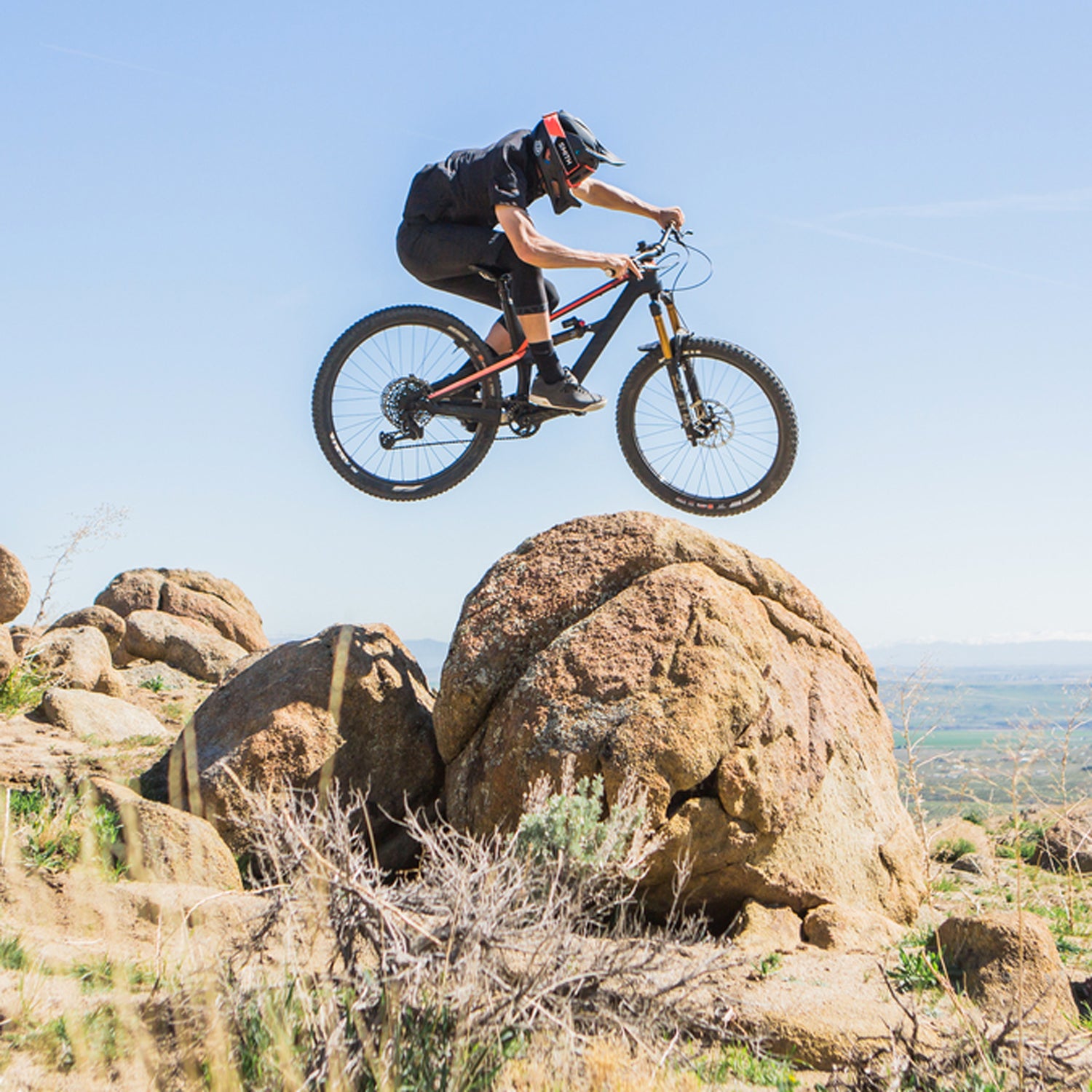Ask mountain biker┬á the trick to whipping gap jumps, bunny-hopping up boulders, and landing a backflip (as┬á, no less), and heÔÇÖll happily share his secret: a workout that can be done in your living room with nothing more than duct tape.┬á
ÔÇťI need short bursts of power and speed to shoot up a climb, clear a gap, or pump through a rhythm section,ÔÇŁ says the┬á30-year-old from Boise, Idaho. ÔÇťThis type of workout develops that strength.ÔÇŁ The former┬áBMX racer and All-American pole vaulter has spent years developing explosive power with plyometric training. Also known as jump training, plyometric exercisesÔÇölike box jumpsÔÇöcondition┬áyour muscles to produce maximum force in the shortest possible time, explains Jim Walker, director of the sports science department at , a Utah-based medical network.┬á
The coronavirus pandemic┬áled to the closure of the bike parks where Bringhurst typically trains, so he developed a short, effective plyometrics workout he can do at home.┬áThe series of rapid-fire jumps that progress in magnitude and intensity┬átake┬áless than half an hour┬áand may feel deceptively easy. ÔÇťYouÔÇÖre not going to sweat a ton or┬áwalk away feeling like youÔÇÖve done a ton of work,ÔÇŁ Bringhurst┬ásays. But this technique is remarkably efficient, thanks to a load-explode pattern that trains your muscles to produce more force more rapidly.┬áThe key is minimizing the amount of time your feet spend on the ground between jumps to create a superfast rebound.┬á
ÔÇťThey call it the stretch-shortening cycle,ÔÇŁ says Greg Myer, director of sports-medicine research at the ChildrenÔÇÖs Hospital in Cincinnati and a coauthor of . ÔÇťYouÔÇÖre lengthening a muscle prior to initiating a rapid contraction.ÔÇŁ Plyometrics trains your muscular reflexes to respond quickly, Myer explains. That neuromuscular control improves coordination, balance, and proprioceptionÔÇöthe awareness of where your body is in space. For athletes who do low-impact sports like cycling or swimming,┬áplyometrics┬á┬áin increasing . ÔÇťWe tend to think of impact as a bad thing. But high-impact, weight-bearing exercise is what makes our bones strong,ÔÇŁ says Walker. These types of exercises also strengthen┬áthe muscles that stabilize your ankles and knees, which helps guard against joint injury.┬á
To set up for your workout, on the ground, make a plus sign thatÔÇÖs two feet squared┬áusing duct tape or painterÔÇÖs tape, and move any nearby furniture two or three feet away.┬áWarm up with a quick jog around the block or five to ten minutes on a┬átrainer, followed by dynamic stretches focusing on your┬áquads and hamstrings.┬áÔÇťWhen youÔÇÖre jumping and landing, really focus on proper technique,ÔÇŁ says Myer. Keep┬áyour knees aligned with your toesÔÇönot buckling inwardÔÇöand land┬álightly┬áon the balls of your feet.┬áDo this workout twice a week when your muscles are fresh, not after a long ride or run. ItÔÇÖs also important to be mentally engaged,┬áas youÔÇÖll need to focus to accurately nail each move.┬á
The Moves
Two-Legged Circle Hops 
What it does: Gets your calf muscles firing with quick, precise movements and prepares your quads and hamstrings for progressively bigger, more dynamic jumps. It also warms up your reflexes by engaging your nervous system. 
How to do it: Stand in one of the quadrants. With your feet an inch or two apart, make quick, small hops (about two inches off the ground) in a clockwise pattern, moving quadrant to quadrant with each hop, for 30 seconds. Make sure to land light-footed and rebound as quickly as possible without losing accuracy. After your first effort, rest for 30 to 60 seconds, until your muscles are fully recovered. Repeat for a total of three clockwise sets, resting between each set.
Single-Leg Circle Hops
What it does: In addition to the benefits of the two-legged circle hops, doing this move on one leg develops proprioception and neuromuscular control.
How to do it: Stand on your right foot in one of the quadrants. With small, rapid jumps, hop counterclockwise through the quadrants for 30 seconds. Make sure to land on the ball of your foot or midfoot, not flat-footed or on your heel. After your first effort, rest for 30 to 60 seconds, until your muscles are fully recovered. Complete three sets on your right leg, resting to full recovery between sets. Then repeat the sequence on your left leg, also going counterclockwise.
Two-Legged Depth Jumps 
What it does: This high-intensity, dynamic move builds explosive power and speed, which helps with dirt jumps, bunny hops, and other big moves on a bike. 
How to do it: With your feet shoulder-distance apart, perform a series of controlled, explosive vertical jumps, aiming for knee height. When your feet come down, land on the balls of your feet and rebound into the next jump with as much power and speed as possible. Do ten consecutive jumps, minimizing the time your feet touch the ground. Rest a full two minutes between each set, until your muscles are fully recovered. Repeat for a total of three sets.
Single-Leg Depth Jumps
What it does: Depth jumps on one leg take things up a notch by doubling the load. They also build strength in the core and the muscles stabilizing your knees and ankles. 
How to do it: DonÔÇÖt attempt these until youÔÇÖve mastered the two-legged version. Stand on your right leg, with your left foot a few inches off the ground. On one foot, do a series of controlled, explosive vertical┬ájumps, aiming for knee height or a little lower. When you land, rebound as quickly as possible. Do five consecutive jumps, making sure your knee stays aligned over your toes. Land on the ball of your foot or┬ámidfoot┬áas quietly as possible. Complete three sets, resting a full two minutes between each set. Repeat the same sequence on the left leg.


